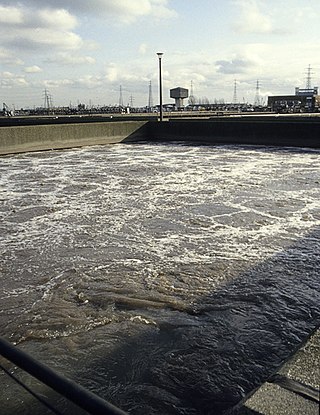
The activated sludgeprocess is a type of biological wastewater treatment process for treating sewage or industrial wastewaters using aeration and a biological floc composed of bacteria and protozoa. It uses air and microorganisms to biologically oxidize organic pollutants, producing a waste sludge containing the oxidized material.
Thiothrix is a genus of filamentous sulfur-oxidizing bacteria, related to the genera Beggiatoa and Thioploca. They are usually Gram-negative and rod-shaped. They form ensheathed multicellular filaments that are attached at the base, and form gonidia at their free end. The apical gonidia have gliding motility. Rosettes of the filaments are not always formed but are typical. Sulfur is deposited in invaginations within the cell membrane.
In treatment of sewage one process used is the activated sludge process in which air is passed through a mixture of sewage and old sludge to allow the micro-organisms to break down the organic components of the sewage. Sludge is continually drawn off as new sewage enters the tank and this sludge must then be settled so that the supernatant can be separated to pass on to further stages of treatment.

The Nocardiaceae are a family of aerobic, non-fastidious, high G+C, Gram-positive actinomycetes that are commonly found in soil and water. Members of this family have been isolated from Antarctic soils. Nocardiaceae present coccobacilli, filamentous or, rarely, fragmented and palisading forms, and filamentous species grow in a branching morphological pattern similar to fungal hyphae.
Hydrogenophaga atypica is a Gram-negative, oxidase-positive, rod-shaped, motile bacterium from the Comamonadaceae family, which was isolated from wastewater from an activated sludge. Colonies of H. atypica are pale yellow.
Aquamicrobium defluvii is a gram-negative, oxidase- and catalase-positive, bacteria from the genus of Aquamicrobium which was isolated from activated sewage sludge in Germany. Oxygen can be used as a terminal electron accpetor. Different carbons were tested but only a few sugars, fatty acids and thiophene 2-carboxylate supported growth The genomic information about these species is limited and more research is needed. . Aquamicrobium defluvii uses thiophene-2-carboxylate as only source for carbon.
Gordonia is a genus of gram-positive, aerobic, catalase-positive bacterium in the Actinomycetota, closely related to the Rhodococcus, Mycobacterium, Skermania, and Nocardia genera. Gordonia bacteria are aerobic, motile, and non-sporulating. Gordonia is from the same lineage that includes Mycobacterium tuberculosis. The genus was discovered by Tsukamura in 1971 and named after American bacteriologist Ruth Gordon.. Many species are often found in the soil, while other species have been isolated from aquatic environments. Gordonia species are rarely known to cause infections in humans.
The Actinobacterial Phage Holin (APH) Family is a fairly large family of proteins between 105 and 180 amino acyl residues in length, typically exhibiting a single transmembrane segment (TMS) near the N-terminus. A representative list of proteins belonging to the APH family can be found in the Transporter Classification Database.
Gordonia alkanivorans is a bacterium from the genus of Gordonia which has been isolated from soil which was contaminated with tar and phenol in Rositz in Germany. Gordonia alkanivorans has the ability to metabolize hexadecane. The strain RIPI90A of Gordonia alkanivorans can desulfurize dibenzothiophene.
Gordonia caeni is a Gram-positive, strictly aerobic, short-rod-shaped and non-motile bacterium from the genus Gordonia which has been isolated from sludge from a sewage disposal plant in Daejeon in Korea.
Gordonia cholesterolivorans is a bacterium from the genus Gordonia which has been isolated from sewage sludge from a sewage treatment plant in Ciudad Real in Spain. Gordonia cholesterolivorans has the ability to degrade cholesterol.
Tsukamurella pseudospumae is a bacterium from the genus Tsukamurella which has been isolated from activated sludge foam from an activated sludge treatment plant in England.
Gordonia malaquae is a bacterium from the genus Gordonia which has been isolated from sludge from a wastewater treatment plant in Taiwan.
Tsukamurella spumae is a bacterium from the genus of Tsukamurella which has been isolated from foam from an activated sludge plant in England.
Millisia brevis is a mycolic acid producing bacterium from the family Nocardiaceae which has been isolated from activated sludge in Australia.
Mucilaginibacter defluvii is a Gram-negative, rod-shaped, aerobic and non-motile bacterium from the genus of Mucilaginibacter which has been isolated from a dye wastewater treatment facility in Korea.
Runella defluvii is a Gram-negative and rod-shaped bacterium from the genus of Runella which has been isolated from activated sludge from a wastewater treatment plant in Pohang in Korea.
Runella defluvii is a Gram-negative, rod-shaped, strictly aerobic and non-motile bacterium from the genus of Runella which has been isolated from activated sludge in Korea.
Flavobacterium defluvii is a Gram-negative and non-spore-forming bacterium from the genus of Flavobacterium which has been isolated from activated sludge from a municipal wastewater treatment plant in Pohang in Korea.
Gordonia sp. nov. Q8 is a bacterium in the phylum of Actinomycetota. It was discovered in 2017 as one of eighteen new species isolated from the Jiangsu Wei5 oilfield in East China with the potential for bioremediation. Strain Q8 is rod-shaped and gram-positive with dimensions 1.0–4.0 μm × 0.5–1.2 μm and an optimal growth temperature of 40 °C. Phylogenetically, it is most closely related to Gordonia paraffinivorans and Gordonia alkaliphila, both of which are known bioremediators. Q8 was assigned as a novel species based on a <70% ratio of DNA homology with other Gordonia bacteria.

